Mazda 3 Service Manual: Windshield Installation
WARNING:
-
Using a utility knife with bare hands can cause injury. Always wear gloves when using a utility knife.
CAUTION:
-
If a door is opened or closed when all the window glass is closed, the resulting change in air pressure could cause the sealant to crack preventing the proper installation of the windshield. Keep the door glass opened until the windshield installation is completed.
-
If the rain sensor is replaced with a new one, the reflection rate when the switching the ignition to on the first time is memorized as a condition that no rainfall is on the windshield.
1. Remove the sealant along the perimeter of the glass using a utility knife. (When reusing the glass)
2. Clean and degrease an approx. 50 mm {2.0 in}
wide strip along the perimeter of the windshield.
3. Inspect the glass for cracks. If it is cracked, chamfer it using sandpaper.
4. Align the alignment marks made before removal and install the pin to the windshield referring to the figure. (Reusing glass, pin removed)
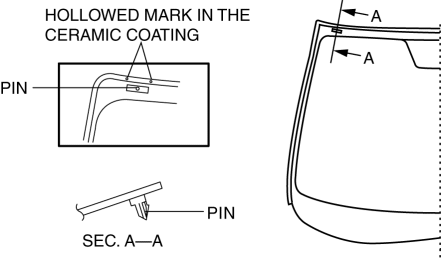
5. Install the windshield molding.
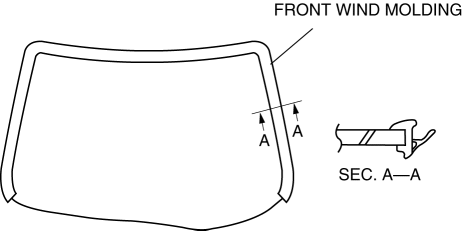
6. Apply glass primer on the glass as shown in the figure, then allow it to dry for approx. 30 min
.
CAUTION:
-
To prevent weakening of the primer adhesion, keep the bonding surface free of dirt, moisture, and grease. Do not touch the surface with your hand.
NOTE:
-
Apply primer to the hollowed marks in the ceramic coating.
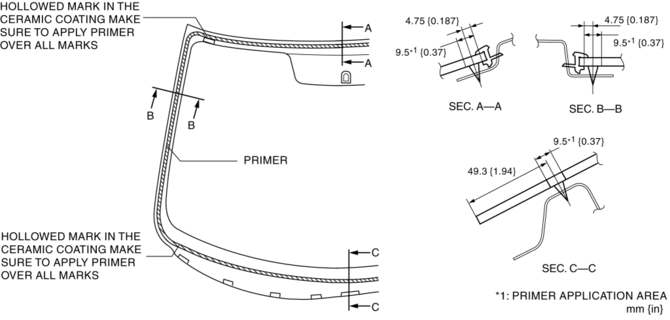
7. Cut away the old sealant using a utility knife so that 1—2 mm {0.04—0.07 in}
thickness of sealant remains along the perimeter of the frame.
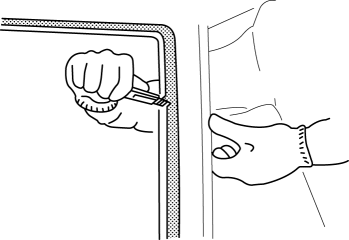
8. If the sealant has come off completely in any one place, apply some primer after degreasing, and allow it approx. 30 min
to dry. Then apply 2 mm {0.08 in}
thickness of new sealant.
CAUTION:
-
To prevent weakening of the primer adhesion, keep the bonding surface free of dirt, moisture, and grease. Do not touch the surface with your hand.
9. Clean and degrease along the perimeter of the bonding area on the body.
10. Apply body primer on the body as shown in the figure, then allow it to dry for approx. 30 min
.
CAUTION:
-
To prevent weakening of the primer adhesion, keep the bonding surface free of dirt, moisture, and grease. Do not touch the surface with your hand.
NOTE:
-
Apply primer to the hollowed marks in the ceramic coating.
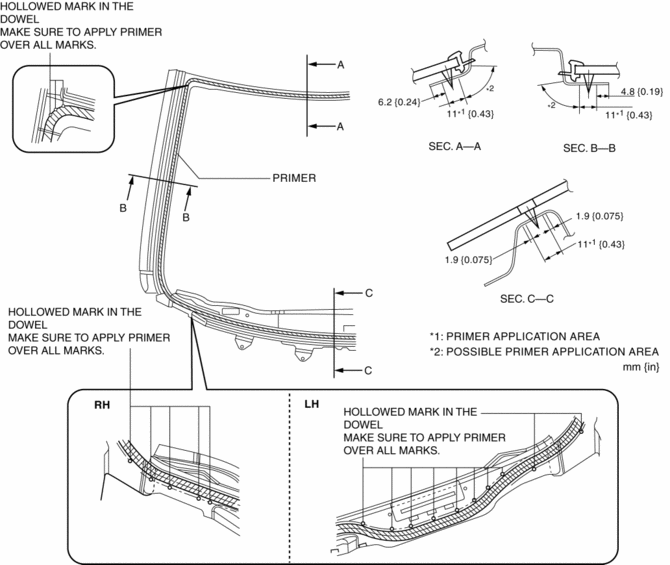
11. Apply sealant to the area of the glass surface as shown in the figure.
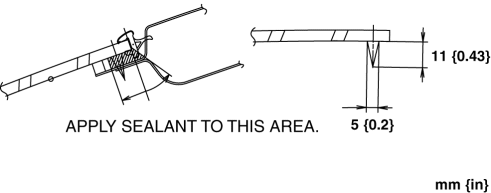
12. Insert the positioning pins to the body and install the windshield.
13. Verify that the clearance between the A-pillar and the roof is within the range shown in the figure, and press along the perimeter of the glass.

14. Install the headliner.
15. Install the following parts:
a. Assist handle.
b. Sunvisor.
c. A-pillar trim.
d. Rear view mirror (Vehicles without auto-dimming mirror).
e. Auto-dimming mirror (Vehicles with auto-dimming mirror).
f. Rain sensor (Vehicles with auto light / wiper system).
g. Cowl grille.
h. Windshield wiper arm and blade.
16. Connect the negative battery cable..
17. Allow the sealant to harden completely. Sealant hardening time: 24 h
 Rear Window Glass Removal
Rear Window Glass Removal
4SD
1. Disconnect the negative battery cable.
2. Remove the following parts:
a. Rear seat cushion.
b. Rear scuff plate.
c. Rear side seat back.
d. C–pillar trims.
e. Rear package trim.
...
 Windshield Removal
Windshield Removal
1. Disconnect the negative battery cable.
2. Remove the following parts:
a. Windshield wiper arm and blade.
b. Cowl grille.
c. Rain sensor (Vehicles with auto light/wiper system).
d. Auto-di ...
Other materials:
Fastening the Seat Belt
Pull the seat belt tongue to the desired
length.
Insert it into the seat belt buckle until
you hear a click sound.
Adjust the belt length.
To lengthen the belt, hold the seat belt
tongue at a right angle to the webbing
and pull. To shorten, pull the loose end
of the webbin ...
Automatic Transaxle Fluid (ATF) Adjustment [Fw6 A EL]
CAUTION:
Only adjust the ATF level when the ATF temperature is 45—55 °C {113—131 °F}.
If the ATF level is incorrect, it could damage the transaxle.
Do not add ATF over the specification. Otherwise, the transaxle performance
could be reduced and ATF could leak.
1. Remove a ...
Locking Lug Nuts
If your vehicle has Mazda optional
antitheft wheel lug nuts, one on each
wheel will lock the tires and you must
use a special key to unlock them. This
key will attach to the lug wrench.
Register them with the lock manufacturer
by filling out the card provided in the
glove compartment and ma ...
